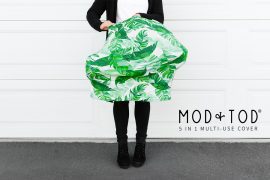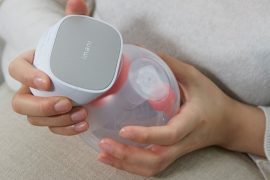- Mums are fiddling around and “checking the latch”. It’s completely understandable that when someone tells you the baby’s mouth should be a certain way and the bottom lip should be flanged out like a fish lip, you think you are supposed to check! But the minute you push your baby’s cheek out of the way and have a bit of a rummage, you’ve made some adjustments. Better to go with a look at the baby as they approach the breast and the mouthful you saw them take and how it feels. And how the nipple looks when it comes out of baby’s mouth (might be elongated but shouldn’t be squashed and flattened at the end). If the baby is close enough, you usually can’t see the lips at all. The rounded part of baby’s cheek is in contact with the breast and the lips are hidden.
- And while we are talking about lips, the top lip doesn’t need to flange out and do the fish lip thing. It can rest in a neutral position. An excessively flanged top lip can even be the sign of a shallow latch. I’ve met several mums who have been told that the top lip should stick out and even flip it out themselves to make that happen. Curled in isn’t ideal but it doesn’t need to flip out.
- Babies are sinking. Mums might start with baby on a squishy pillow and as the feed goes on, gravity does evil things and the baby starts to sink. The movement might be imperceptible but it’s enough to pull the baby away from the breast. That pregnancy pillow filled with beans that the manufacturers claimed was super for breastfeeding? Meh. If it’s bean-filled, it’s likely to sink. That favourite feather-filled bed pillow? Going to sink. Holding all the weight of your baby on your arms and hands and sitting bolt upright? You are going to sink. You are not designed to hold the weight of your baby in that position for minutes and minutes throughout the day. It’s a big clue if you finish a feed rubbing your wrist and thinking, “Phew, glad that’s over!” Gravity is your enemy. You need to find a position which you can sustain. That might be the right cushion for you (or more than one) or again, it might be about leaning back. Babies also latch better when they are anchored. If they feel themselves slipping, they may even clamp down and things can get even more sore.
- What’s the bottom cheek doing? Not many of us have nipples that come out from our body at precise right angles. So why do so many of us feed a baby as if that’s true? The baby is precisely “tummy to mummy” and lying on a breastfeeding cushion as if our nipples are pointing directly in front of us. In fact, most women have nipples that point slightly down (or off to one side and down). But we put baby into the “right angle” position anyway. What ends up happening is that the top cheek (which mum can see in a cross-cradle or cradle position) is nice and close to the breast and rounded. However the bottom cheek can be centimetres away from mum’s body with an unhelpful gap for air to get in and a shallowed latch. Get someone to check that the bottom cheek is touching the breast too. Look at your natural body shape. Your baby may need to look up towards your shoulder rather than at the back of the chair. You may be able to see both of their eyes.
- Ear/ shoulder/ hip in alignment. Get that glass of water again. Twist your neck and try to take a drink. It’s rrrreally hard. And if what you were drinking was gradually getting thicker and fattier, again, you’re likely to be taking in air and giving up sooner than you might. Baby can’t lie on their back and twist their neck towards you to come to the breast. We want the ear and shoulder and hip to all be pointing in the same direction. Even a baby with a twisted torso and the twist is around the hips can run into problems.
- Look at your body. Look, that mum over there in Costa seems to be able to drink her coffee (yes, you can drink coffee) and is just supporting her baby on one arm! How the heck! Can I do that? You know how hairdressers’ clients turn up to their appointments with a celebrity photo and say, “Make me look like that!” That sometimes happens in breastfeeding too. “Can I hold my baby like that mum I saw?”
Sometimes the answer is yes and sometimes it’s no. Your humerus is the bone that goes between your shoulder and your elbow. Sometimes your humerus bone and the height of your breast isn’t ideal for particular positions. Long humerus and high firm breast? You may not be able to do the cradle hold. I mean seriously – you may NEVER be able to do the cradle hold. The baby will be too low. Short humerus and long low breast? You may not be able to do the position that that woman in Costa can do and drink coffee. You might always need a hand to support the breast if you want to do the cradle hold.
It’s not all about the pictures in that breastfeeding book or what your mates are able to do. It’s about the shape of your body and the shape of your baby. Do you need to factor in wheelchair arms? Do you need to think about how your breast texture changes in the day? It’s all very individual. Trying to make it work like everyone else does it can be unhelpful – which is why getting face-to-face help tailored to you can be so useful.
- Give the baby more space for their tongue on the breast. You may have heard people talk about baby getting more of a mouthful of breast below the nipple than above. Or seeing some areola above the top lip and less (or none) below the bottom. If the baby has more space for their tongue on the breast, they have a chance of scooping more breast into their mouth and the latch being deeper. When the nipple is going in, picture it pointing towards the roof of baby’s mouth rather than pointing down the back of their throat. Even just a little bit of re-angling can make things easier.
- Don’t make your baby eat cotton. Breastfeeding clothes also assume we’re all the same. If you find them a faff – as you pull open a teeny slit to find your nipple hidden in there somewhere – I’m pretty sure your baby does too. If they ping back so the baby’s nose and cheek comes back into contact with fabric again, maybe rethink. I’ve even seen babies with fabric in their mouths with a look of resignation that says, “This is the best I’m going to get”. Cheap vest tops you can pull out of the way are very sensible. You can layer more than one so different bits are covered. And a bulldog clip is useful for securing fabric (not your chin holding your clothing and preventing it from flopping down onto baby’s face).
As I say, some of that really isn’t complicated. It’s what we talk through on the breastfeeding helplines and what we point out every day in breastfeeding support groups. While at the same time NOT saying that it’s “normal” to be in pain at 10 days or your nipples just need to get used to things. If you feel breastfeeding is just all too hard, remember you could be seconds away from fixing things.
Originally published HERE.
After a career as a Deputy Headteacher in central London, Emma initially trained with UK charity Association of Breastfeeding Mothers (www.abm.me.uk), qualifying as a breastfeeding counsellor with them in 2007. She is currently their chair. She qualified as a Board Certified Lactation Consultant (IBCLC) in 2011 and combines a small private practice with volunteering at two groups a week and answering calls on the National Breastfeeding Helpline. You can find her on Twitter as @makesmilk. She spoke at the UNICEF Baby Friendly UK conference in November this year on the theme of responsive feeding. Her book, “You’ve Got It In You: a positive guide to breastfeeding” can be found on Amazon and from other retailers: http://www.amazon.co.uk/dp/B019JE5E44










